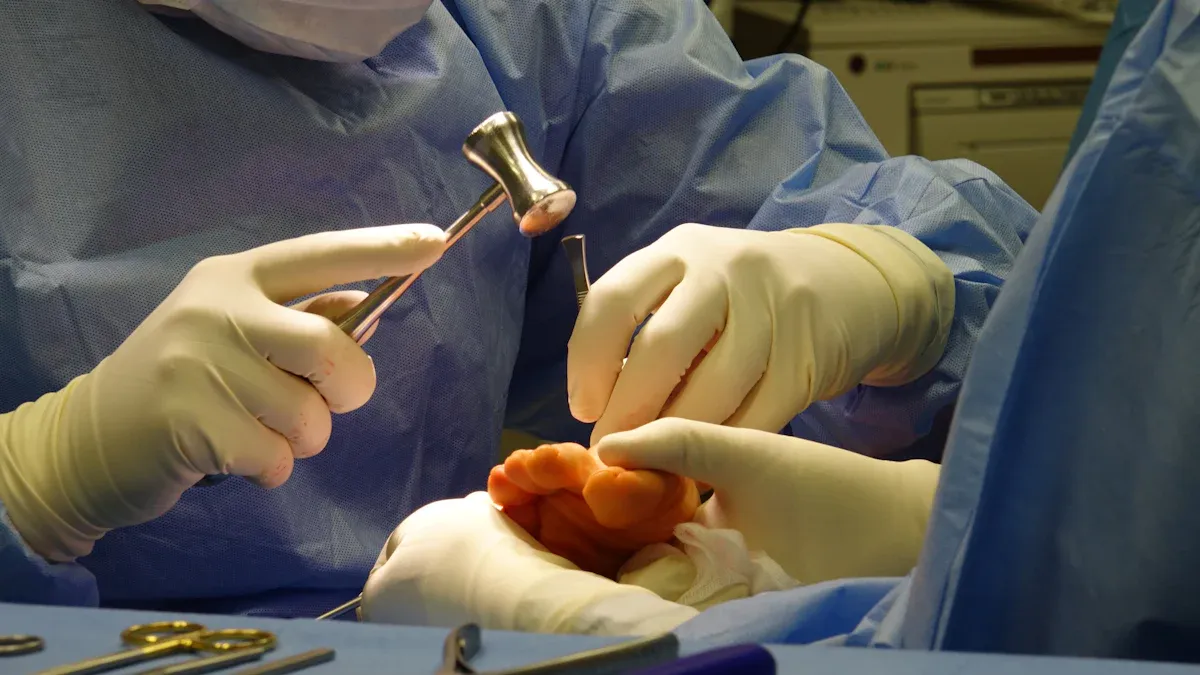How Nitinol Tubing Enhances Thrombectomy Stent Performance

Nitinol tubing for thrombectomy stent OEM has significantly enhanced the functionality of thrombectomy stents. Its unique properties, such as shape memory and flexibility, allow stents to conform perfectly to blood vessels, facilitating the effective removal of clots. Research indicates that well-sized stents achieve an 88% success rate, whereas oversized stents only succeed 70% of the time. Improved performance reduces complications like blood vessel narrowing. Nitinol tubing contributes to the flexibility and efficacy of stents in clot removal, resulting in safer treatments and improved patient care.
Key Takeaways
Nitinol tubing improves stents by being flexible and holding shape. This helps stents fit well in blood vessels to remove clots.
Stents made of nitinol work 88% of the time when sized right. This helps patients recover better and lowers surgery problems.
Nitinol bends easily without breaking, so it works well in tight or tricky blood vessels during surgeries.
Nitinol is safe for the body and doesn’t cause clotting or bad reactions. This helps patients heal faster.
Nitinol stents can be custom-made for specific surgeries. This makes them work better and keeps surgeries safer.
What Makes Nitinol Unique?

Shape Memory and Its Role in Medical Devices
Nitinol is special because it can return to its original shape when heated. This happens due to its unique crystal structure, which changes at body temperature (37°C [98.6°F]). Medical tools like stents use this feature to work better. For instance, nitinol stents can be squeezed small for insertion and then expand back inside the body. This reduces pain for patients and helps them heal faster.
Tip: Nitinol is great for small surgeries since it adjusts easily to the body.
Nitinol is also very strong and can handle a lot of pressure. Its shape memory and flexibility help stents fit into tricky blood vessels. This makes clot removal easier and lowers risks.
Superelasticity for Enhanced Flexibility
Nitinol can bend a lot without breaking, thanks to its superelasticity. This is important for stents used in clot-removal surgeries, where bending is needed to move through tight blood vessels. Tests show nitinol is very tough, with wires lasting through 10 million bends under different pressures.
Metric | What It Measures |
|---|---|
Fatigue Life | How many bends it can handle before breaking. |
Tensile Strength | The heaviest load it can take before failing. |
Residual Elongation | The stretch difference between loading and unloading. |
This bending ability keeps nitinol stents strong during hard surgeries, making them more reliable and helpful for patients.
Biocompatibility for Safe Medical Applications
Nitinol is safe for the body, which is why it’s used in medical tools. It doesn’t rust easily because of a titanium oxide (TiO2) layer on its surface. This layer protects it and helps it last a long time inside the body.
Studies prove nitinol is safe. For example, the DAWN Trial showed 49% of stroke patients treated with nitinol stents could live independently after 90 days. Its safety reduces immune reactions and problems like clotting or rejection.
Note: Nitinol’s safety is why it’s so popular in stents. It protects patients and improves treatments.
Nitinol Tubing for Thrombectomy Stent OEM
Flexibility for Navigating Complex Vascular Pathways
Nitinol tubing helps stents bend easily in tight blood vessels. Brain vessels and others often have sharp turns and narrow spaces. Stents made from nitinol can adjust to these tricky areas. Its superelasticity and shape memory keep the stent strong while bending.
This bending ability is useful for removing clots. A nitinol stent retriever can move through hard-to-reach vessels to grab clots. Once placed, the stent opens to its original shape. This helps catch clots well and lowers the chance of vessel damage.
Note: Nitinol stents are great for treating brain vessel problems like aneurysms.
Efficiency in Mechanical Thrombectomy Procedures
Mechanical thrombectomy removes clots to restore blood flow. Nitinol tubing helps stents work better during this process. Its shape memory lets stents shrink for insertion and expand later. This makes clot removal more accurate and effective.
Custom nitinol stents improve performance by matching specific surgery needs. For example, stents can be designed for delicate brain surgeries. Studies show nitinol stents remove clots better than older materials.
Nitinol is also safe for the body, reducing clot buildup on stents. This makes surgeries smoother and helps patients recover faster. Nitinol tubing is key for making advanced clot-removal tools.
Durability and Reduced Risk of Complications
Durability is important for stents to work well over time. Nitinol tubing resists rust, keeping stents strong inside the body. This lowers risks like stent failure or vessel narrowing.
Nitinol stents gently press against vessel walls, avoiding injury. A study in 2019 showed only 4.1% of patients had vessel narrowing after using nitinol stents. This proves their long-term reliability.
Another study in 2022 found fewer strokes in patients with nitinol stents. This shows how durable and safe nitinol is for treatments. Manufacturers can improve stents with special designs like surface changes.
Tip: Custom nitinol stents can make surgeries safer and more effective.
Making and Customizing Nitinol Stents
Heat Treatment for Better Shape Memory
Heat treatment helps nitinol stents keep their shape memory. By changing the heat levels, makers can adjust how nitinol works in the body. For example, at lower heat (under 600°C), nitinol's transformation temperature rises because of fewer defects and small particles forming. At higher heat (over 600°C), the material changes as particles dissolve and crystals reform.
Heat Level (°C) | Transformation Temp (°C) | What Happens |
|---|---|---|
Below 600 | Higher with heat | Fewer defects, small particles form |
Above 600 | Lower with heat | Crystals reform, particles dissolve |
400 | B2 → B19 change seen | Low heat enough for transformation |
800 | B19 ↔ B19′ change seen | Needs high heat after crystal changes |
This careful heating makes sure nitinol stents can expand and fit blood vessels during surgeries.
Surface Changes for Safer Use
Changing the surface of nitinol stents makes them safer for the body. Methods like acid washing, passivation, and hydrogen peroxide treatment help reduce problems like clotting or irritation. For instance, acid washing with HNO3 lowers nickel release, while passivation stops rust and helps cells stick better.
Surface Method | How It Helps | Study Source |
|---|---|---|
Acid wash with HNO3 | Lowers nickel release, less clotting | Norouzi and Nouri, 2021 |
Heat treatment | Stops rust, lowers toxicity | Chakraborty et al., 2019 |
Passivation | Stops rust, helps cells stick | Gill et al., 2015 |
Rubbing | Improves surface for better use | Pérez et al., 2009 |
Hydrogen peroxide | Makes it safer for the body | Norouzi and Nouri, 2021 |
These changes make nitinol stents work well and last longer in the body.
Micro-Patterns for Better Performance
Adding tiny patterns to nitinol stents improves how they work. Patterns like stripes or circles help stents grab clots and move through tricky blood vessels. Studies show stents with patterns work better than plain ones.
Stent Type | Details |
|---|---|
No Patterns | Plain stents, no added designs |
Stripe Patterns | Stents with stripe designs |
Circular Patterns | Stents with circle designs |
These patterns let makers design stents for specific surgeries, helping patients recover better.
Real-World Uses and Benefits of Nitinol Tubing
Success Stories in Clot Removal
Nitinol tubing has improved clot-removal surgeries by making stents work better. Devices like the EMBOTRAP, made with nitinol, show its strengths. The EMBOTRAP can bend and return to shape, helping it move through brain vessels and grab clots. It removes clots in under 10 minutes, saving time during surgery.
Device Name | Material Used | Key Features | Procedure Time |
|---|---|---|---|
EMBOTRAP | Nitinol | Bends easily, returns to shape | Under 10 minutes |
These improvements show how nitinol helps patients recover faster and lowers surgery risks. Its safety makes it less likely to cause clots or harm blood vessels.
Why Nitinol is Better Than Older Materials
Nitinol stents are better than older ones like stainless steel. They bend easily without breaking, making them great for tricky brain vessels. Unlike stiff materials, nitinol stents keep their shape after bending, making them more reliable.
Older stents often cause clots or vessel narrowing. Nitinol’s safety reduces these problems, making it a better choice for brain surgeries. It also removes clots more precisely, improving surgery success rates. Nitinol’s mix of flexibility, strength, and safety makes it essential for modern clot-removal tools.
AccuPath’s Role in Nitinol Tubing for Stents
AccuPath is a top maker of nitinol tubing for stents. Studies show nitinol stents help over 50% of patients recover well, based on the modified Rankin Scale. AccuPath’s careful designs ensure their stents work at the highest level.
Group | Median Total COF (N) | Restenosis Rate | P-Value |
|---|---|---|---|
High COF | 55.69 | Higher | < .001 |
Low COF | 14.89 | Lower |
AccuPath’s stents also reopen blocked vessels very well. For example, the Solitaire FR and Tonbridge Stent reopen vessels completely (TICI 3) in 86.7% of cases. This shows AccuPath’s focus on making better stents with nitinol tubing.
Device | Complete Recanalization Rate (TICI 3) | Safety Endpoints Comparison | Clinical Outcomes Comparison |
|---|---|---|---|
Solitaire FR | 86.7% | Similar | Similar |
Tonbridge Stent | Similar to Solitaire FR | Similar | Similar |
Using advanced methods, AccuPath creates nitinol tubing that makes clot-removal surgeries safer and more effective.
Nitinol has improved thrombectomy stents with special features like shape memory, superelasticity, and resistance to rust. These qualities help stents fit into tight blood vessels, making clot removal easier and safer. Custom nitinol stents are even more flexible and effective, helping patients recover better.
Studies show nitinol stents work very well in surgeries. For example, they reopen blocked vessels 100% of the time, and 55% of patients have good recovery results. The success rate is 97%, with only 4.1% of patients having major problems.
Evidence Type | Result |
|---|---|
Recanalization Rates | Up to 100% |
Functional Outcomes | 55% of patients with good recovery |
Technical Success Rate | 97% (70 of 72 patients) |
Complete Aneurysm Exclusion | 79.2% (57 of 72 patients) |
Aneurysm Occlusion at 12 months | 96.7% (29 of 30 patients) |
Major Complications | 4.1% (3 patients) |
Death in Early Postintervention | 1.4% (1 patient) |
Thrombectomy Success Rate | 83% in restoring blood flow |
Favorable Outcomes at 3 months | 45% of patients |
AccuPath is a leader in making better thrombectomy stents. Their nitinol tubing is strong, safe, and works well. Using advanced methods, AccuPath creates stents that improve surgeries and help patients heal faster.
FAQ
What is nitinol, and why is it used in thrombectomy stents?
Nitinol is a special metal that remembers its shape. It can bend and return to its original form. This helps stents fit into tricky blood vessels and remove clots better.
How does nitinol improve patient safety during thrombectomy procedures?
Nitinol is safe for the body and doesn’t cause bad reactions. It bends easily, which lowers the chance of hurting blood vessels during surgery.
Can nitinol stents be customized for specific medical needs?
Yes, nitinol stents can be changed to work better. Heat, surface changes, and tiny designs make them fit different surgeries.
How durable are nitinol stents compared to traditional materials?
Nitinol stents don’t rust and stay strong under pressure. They last longer and work better than older materials like steel.
Are there any real-world examples of nitinol stents in use?
Stents like EMBOTRAP, made from nitinol, show great results. They move through tight vessels, grab clots fast, and help patients recover quicker.
See Also
Nitinol Tubing's Impact on Modern Medical Innovations
The Importance of Nitinol Tubing in Minimally Invasive Surgery
Nitinol Tubing's Transformative Effect on Medical Equipment

